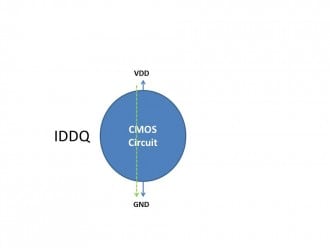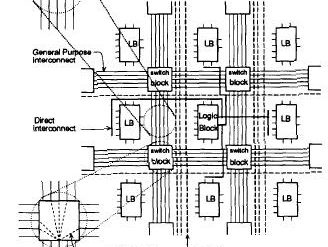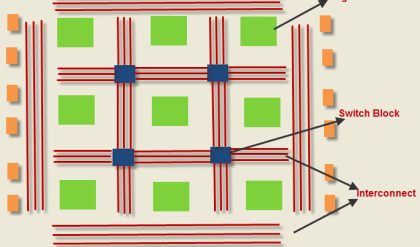DC TRANSFER CHARACTERISTICS OF CMOS INVERTER
The general arrangement and characteristics are illustrated in Fig. 1 . 1 . The current/voltage relationships for the MOS transistor may be written as,

Where Wn and Ln, Wp and Lp are the n- and p- transistor dimensions respectively. The CMOS inverter has five regions of operation is shown in Fig.1.2 and in Fig. 1.3.

Considering the static condition first, in region 1 for which Vin = logic 0, the p-transistor fully turned on while the n-transistor is fully turned off. Thus no current flows through the inverter and the output is directly connected to VDD through the p-transistor.
In region 5 Vin = logic 1, the n-transistor is fully on while the p-transistor is fully off. Again, no current flows and a good logic 0 appears at the output.
In region 2 the input voltage has increased to a level which just exceeds the threshold voltage of the n-transistor. The n-transistor conducts and has a large voltage between source and drain. The p- transistor also conducting but with only a small voltage across it, it operates in the unsaturated resistive region

In region 4 is similar to region 2 but with the roles of the p- and n- transistors reversed.
The current magnitudes in region 2 and 4 are small and most of the energy consumed in switching from one state to the other is due to the large current which flows in region 3.
In region 3 is the region in which the inverter exhibits gain and in which both transistors are in saturation.
Write
The currents in each device must be the same since the transistors are in series. So we may
I dsp = – Idsn
Vin in terms of the β ratio and the other circuit voltages and currents
Vin = VDD + Vtp +Vtn (βn + βp)1/2 / 1+ (βn + βp)1/2
Since both transistors are in saturation, they act as current sources so that the equivalent circuit in this region is two current sources so that the equivalent circuit in this region is two current sources in series between VDD and VSS with the output voltage coming from their common point
The region is inherently unstable in consequence and the change over from one logic level to the other is rapid.
Since only at this point will the two β factors be equal. But for βn= βp the device geometries must be such that
µ pWp/Lp = µ n Wn/Ln
The motilities are inherently unequal and thus it is necessary for the width to length ratio of the p- device to be three times that of the n-device, namely
Wp/Lp = 2.5 Wn/Ln
The mobility µ is affected by the transverse electric field in the channel and is thus independent onVgs.
It has been shown empirically that the actual mobility is
µ= µ z (1 – Ø (Vgs – Vt)-1
Ø is a constant approximately equal to 0.05 Vt includes anybody effect, and µ z is the mobility with zero transverse field.





